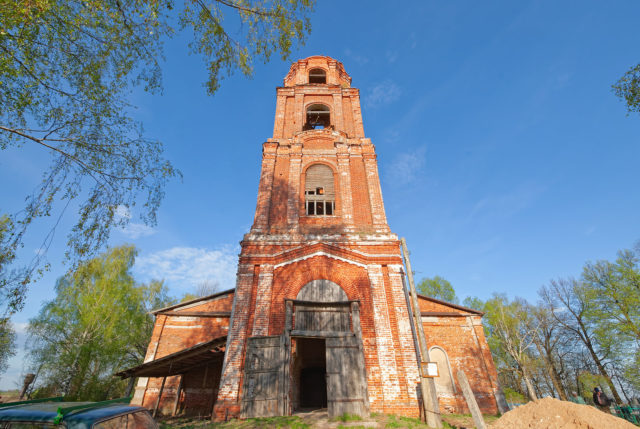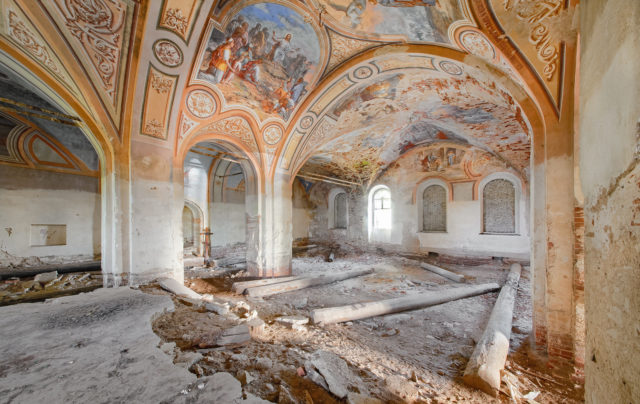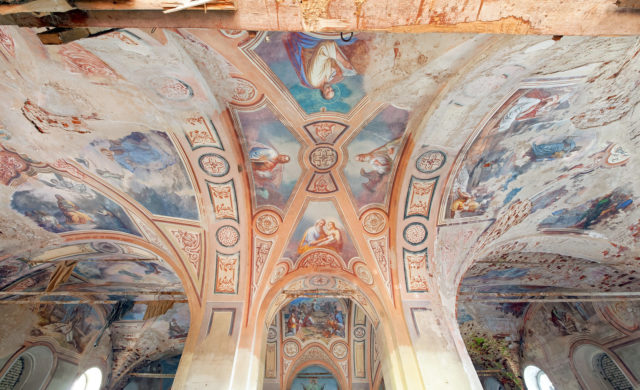Throughout Russia, there are quite a few rural churches that are in disrepair. The Church of the Annunciation of the Blessed Virgin Mary in Tver Oblast, Russia, is no exception.
However, although this inactive Orthodox church is abandoned, the building is in relatively good shape, given its outward appearance and the state of the bell tower. There are also beautifully preserved paintings inside. Part of this is due to superb craftsmanship, but some of it is also due to the efforts of locals.

The church is located in a village called Apukhtino. It is built of bricks in the style of classicism with a single dome. Such elaborate architecture is rare for small villages, and even though it is falling into ruin, its beauty is still evident.
Some sources indicate that a wooden church was standing in this location in the 17th century, going on to be replaced by a stone structure around 1776. Then, in 1881, an unknown architect (believed by some to be Karl Ivanovich Gelbig) began a ten-year process to construct the current church.

Although the original building had a bell tower and refectory, these were changed or improved for the new structure. The bell tower was moved a few meters to the west so that the refectory could be enlarged. Of the original church, only an octagon tower of white brick remains.
Inside, the walls were adorned with paintings based on engravings by the German romantic artist Julius Schnorr von Karolsfeld. However, while they might have a common theme, the paintings were done by several different artists over the years.

In those days, a large number of religious buildings were under construction in Russia due to the fact that many members of the population were Christian. Some of them are still operational today, despite the devastation suffered during the Soviet years, indicateing the excellent quality of the original construction work.
Services were held at the Church of the Annunciation until the 20th century. During the first years of the 20th century, the formation of a new government resulted in several churches in the country being plundered when a large scale campaign against religious organizations began in 1929.

Although these events had a negative effect on this church, it did not close until 1937. At that point, the bells were removed and the altars destroyed. Afterward, the building was used as a warehouse and granary for the village of Apukhtino.
It is known that the building was renovated in the early 1990s while the church was being used as a storehouse. No restoration work was carried out before that since it was not required – further proof of the quality of the original craftsmanship.
However, after the church was abandoned, nature and neglect started to take its toll. The roof was not repaired, so it began to disintegrate, and the vaults of the refectory collapsed.

The foundation, walls, the dome of the nave, and the dome of the bell tower have all survived to this day. Unfortunately, the church building is not listed in the property registers, which means that no one owns it, so there’s no private individual to take care of it.
In addition, it cannot be allocated regional funds for restoration unless it is officially part of a religious organization. The Orthodox Church doesn’t want to claim the building because the number of local residents has decreased so much that there isn’t a suitable congregation to justify its reopening. They see this church as useless and redundant.

However, those living nearby have a different attitude. In the spring of 2011, local volunteers removed the trees that were growing on the walls of the church, managing to halt the destruction of the building somewhat. The area began to be cleaned regularly, and local residents started collecting funds to restore the church.
Such an impressive response by the locals inspired others who donated money to repair and save this remarkable village church. This enabled volunteers to create a temporary shelter for the dome to prevent further destruction, and then three years later to cover it with iron.
The project is still ongoing. The volunteers have made a temporary covering for the remaining walls to prevent further destruction from precipitation. Next, they hope to repair the roof of the bell tower since it’s in danger of imminent collapse.

The photographs of the Russian church were taken in 2018 by Vsevolod Chuvanov. Vsevolod runs a LiveJournal blog where he shares his work about abandoned places in Russia. His Instagram page is also full of amazing photographs of decaying locations.
A big thank you to him for giving us permission to share the photos of this gorgeous church.


Another Article From Us: Military Helicopter Graveyard St Petersburg, Russia

